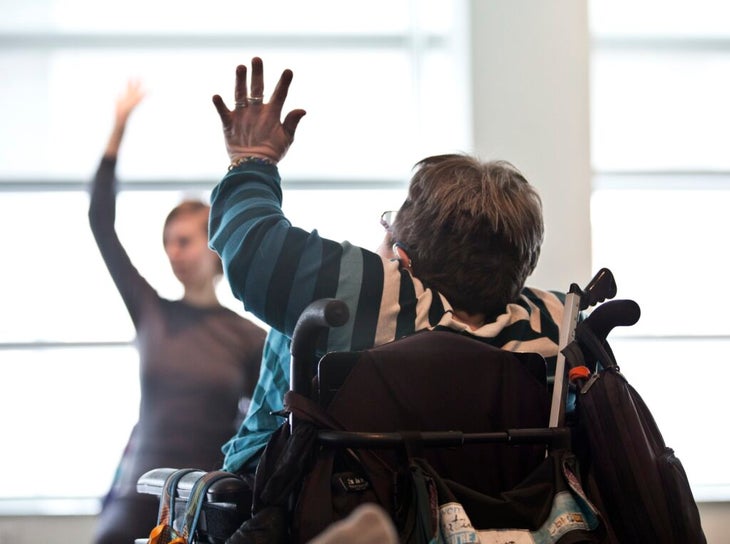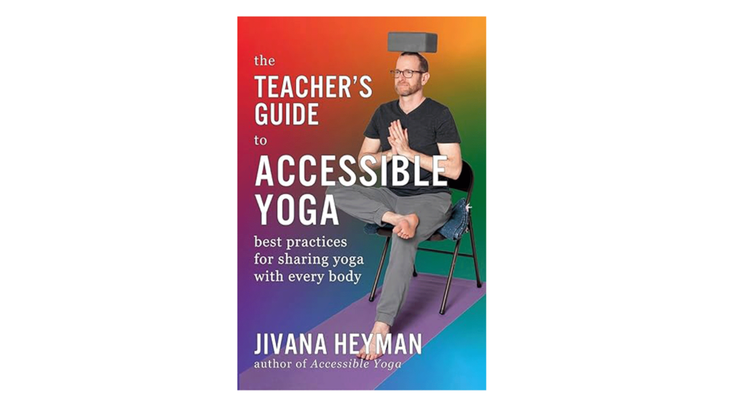Heading out the door? Read this article on the new Outside+ app available now on iOS devices for members! <a href="https://outsideapp.onelink.me/wOhi/6wh1kbvw" class="o-content-cta-link" data-analytics-event="click" data-analytics-data="{"name":"Element Clicked","props":{"destination_url":"https://outsideapp.onelink.me/wOhi/6wh1kbvw","domain":"<>","name":"in-content-cta","type":"link"}}”>Download the app.
The phrase “accessible yoga” has become increasingly common in recent years. Although there’s no denying this is a beneficial thing, it’s essential that those who take and teach yoga truly understand what that concept means and the many ways that it takes shape. In his latest book, the founder of the Accessible Yoga Association, Jivana Heyman, explores some of the ways that teachers misunderstand our role and overlook the actual needs of those who entrust themselves to our classes. His insights remind us that we teachers need to remain students first. —Renee Schettler, Executive Editor
For many reasons, being a yoga teacher can feel confusing. On the one hand, you have knowledge of the practices and experience practicing and teaching. The student probably has less experience and knowledge of yoga, but they do have their own inner wisdom. So the paradox is that you have knowledge and they have wisdom. That’s potentially the perfect combination to create the alchemy of yoga, but it can be a delicate balance. In the end, our job isn’t so much to teach yoga but to guide the student to become their own teacher.
In the Bhagavad Gita, Krishna talks about the difference between a wise and unwise person, which feels important for yoga teachers to consider. He explains that an unwise or unenlightened person simply has more attachments than the wise person. Attachment, vairagya, refers to our relationship to the things in the world that we mistakenly think we need to be happy. As teachers, our job isn’t just doing longer meditations or more complicated asanas. Our job is to release our attachments and to guide students by example. He explains:
“The unenlightened do things with attachment (wanting some results for themselves). An enlightened person does things with the same zeal, Arjuna, but without attachment, and thus guides others on the path of selfless action (karma yoga). A wise person will not disturb the mind of an unwise person who is still attached to the fruits of their actions. But by continuously performing perfect (selfless) actions the wise person influences others in all they do.” 1
When a new student comes to you, do you see problems that need to be fixed? A “bad” back, a hunched spine, a stressed mind? Is your goal to change them, improve them, make them “better”? What kind of relationship starts like that—with only seeing the other person’s limitations? No matter how skilled you are as a yoga teacher or yoga therapist, you’re not going to heal anyone from anything. They might heal themselves with your guidance, but that’s on them, not you.

Your Students Don’t Need To Be “Fixed”
A student once shared a story about his experience with another yoga teacher. He uses a wheelchair, and hesitantly went to a yoga class. The teacher immediately pounced on him and, rather than asking him questions, started to make claims about the benefits of yoga. She even had the nerve to tell him that if he attended her classes regularly she would help him walk again!
This was wrong on so many levels. The most insidious thing about that teacher’s statement was that she assumed that the student wanted to walk. She had no idea why he was using a wheelchair or what using the wheelchair meant to him. Let’s just say that he almost gave up on yoga after that experience.
This story reminds me of the ways we use language. For example, saying someone is “wheelchair bound” or “bed bound” makes an assumption about their relationship to the supports they’re using. Most wheelchair users that I know say that they consider their chair a source of freedom, not limitation.
If your goal is to fix your students, you’ll be fighting an uphill battle. Life brings illness, disability, and eventually death. It’s unavoidable. While yoga provides tremendous benefits, it’s dangerous to bring a strictly therapeutic approach to a spiritual practice. It can create confusion and often is based on ableism and healthism. While it’s natural to want to reduce your students’ suffering, it’s important to reflect on where that desire comes from.
Reflection
Do you assume your older students are trying to regain their youth, larger‑bodied students are trying to lose weight, or disabled students want to be fixed or healed?
Recognizing Your Students’ Agency
If you see your students as already whole and full, you are cultivating a very different relationship with them than you would be if your intention were to fix or change them. Plus, if you start taking responsibility for your students’ healing, how will you feel when they get sick or die? Think of the burden you are carrying, and how much pressure you are putting on yourself. I found that taking on that responsibility was burning me out.
Early in my teaching journey, many of my students with AIDS passed away. Each loss was devastating and made me question what I was doing, but somehow I found the will to keep teaching. Then just a few years ago, I was working with a young woman who had an unusually severe form of multiple sclerosis. Each week when she would come to class, she would have worsened symptoms, and she was really struggling. I felt completely powerless, and wasn’t sure how to help her.
So I approached one of my yoga teacher friends to ask him what else I could do to support her. He stopped me and simply said, “You’re making it about you.” It was such a great example of how helpful peer support is. His reflection made me see the situation in a different way.
This student’s journey was hers, and I was judging it and deciding how it should go. Once I was able to let go of my desire to control, I realized that her journey of illness and wellness was hers alone. I was just supporting her personal evolution. Soon afterward she passed away. It was very upsetting, but my friend’s insight made it more bearable for me.
Building your students’ agency means encouraging them each to listen to their inner voice, their intuition, and their inner wisdom. That’s the way they can access the true power of yoga. I often tell my students, “Listen to me, but don’t listen to me.” Hear the words that I’m saying, but follow your inner guidance.
The other day, during class, a student asked me, “How should this feel?” That question is the sign of an open mind, which I appreciate. But it also speaks to their desire to do it “right,” to fit in, and potentially, to their expectation that growth will happen in a particular way. I responded to the student with, “You tell me. What are you feeling?”
Interoception is the sense of what is happening inside the body, and can be cultivated through yoga practice. By bringing their awareness within, students can create more capacity to listen to that inner voice, respond to those inner sensations, and practice in a way that is in alignment with what they’re feeling in the moment. That’s the mark of an experienced practitioner—increased sensitivity to their inner world, not increased sensitivity to a teacher’s instructions.
Some ways to encourage that inner journey in your students is to invite them to listen to themselves, to identify the sensations that they’re experiencing as they practice, to do body scans, and bring awareness to different parts of the body in a neutral, non‑judgmental way. That last point alone is transformational. Asking them to notice how they feel before and after they do a particular practice can be very effective in increasing self‑awareness. Also, helping students become aware of the way they talk to themselves can be a lifelong gift.
Reflection
Is it difficult for you to sit with your students’ suffering?
Do you feel like a failure if they come to your classes and don’t have less suffering?
1 Swami Satchidananda, The Living Gita: The Complete Bhagavad Gita, (New York: Henry Holt & Co, 1990), sloka 3.25-26

Excerpted with permission from The Teacher’s Guide to Accessible Yoga by Jivana Heyman (Rainbow Mind Publications).
About Our Contributor
Jivana Heyman, C-IAYT, is the founder and director of Accessible Yoga, an organization dedicated to increasing access to yoga teachings and supporting yoga teachers. He’s the author of the books Accessible Yoga: Poses and Practices for Every Body; Yoga Revolution: Building a Practice of Courage & Compassion; and The Teacher’s Guide to Accessible Yoga: Best Practices for Sharing Yoga with Every Body. Learn more at jivanaheyman.com.





